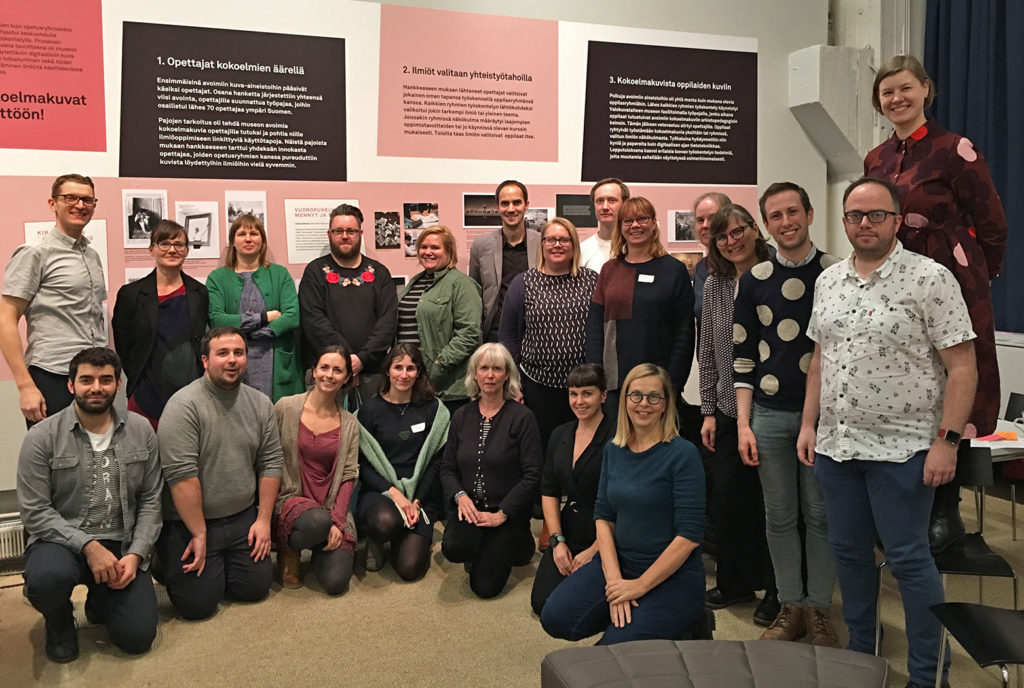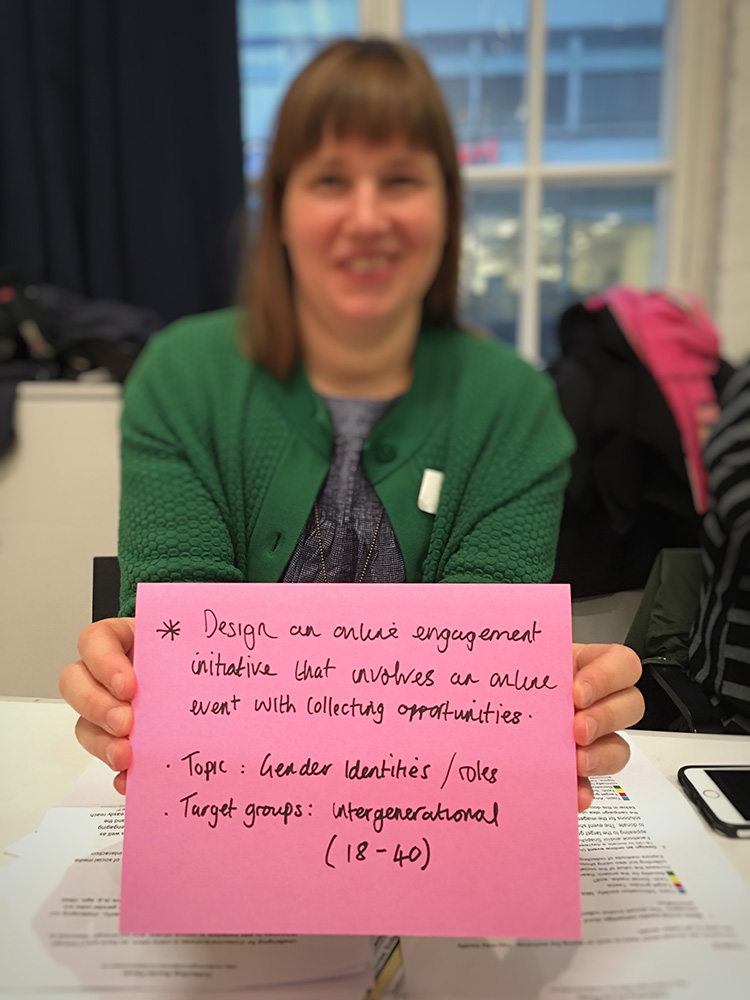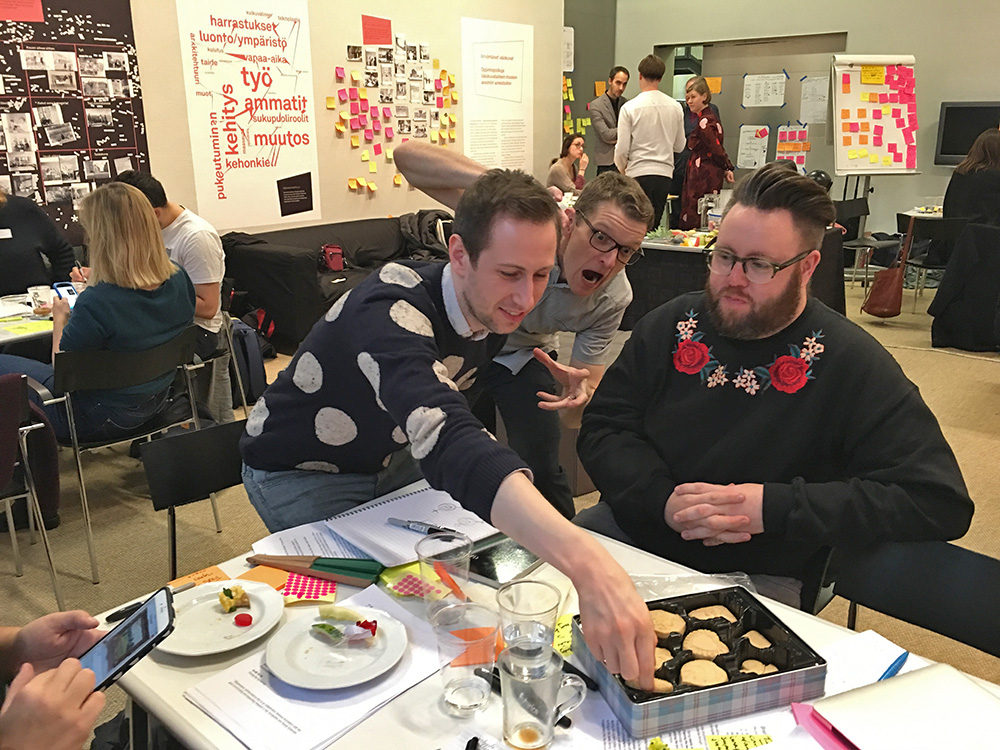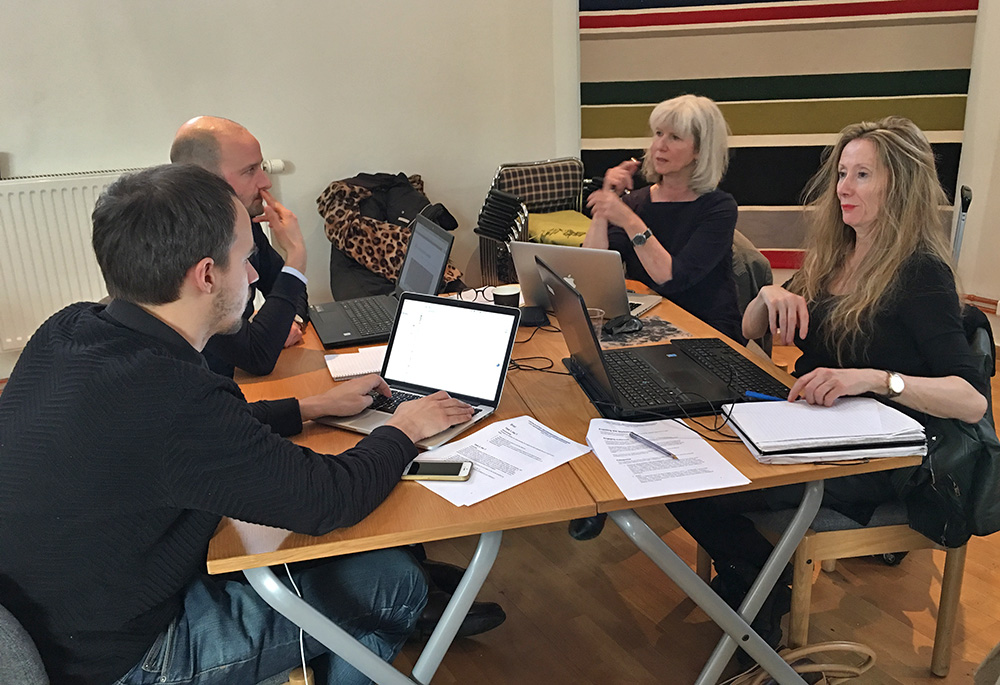This is a report from the Collecting Social Photo project, a three year research project funded by Swedish Riksbankens Jubileumsfond. The project’s main goal is to develop new recommendations, for museums and archives in Denmark, Finland and Sweden, for collecting and disseminating social digital photography.
The project is founded on three research questions:
- Q1: How can data collection policies and practices be adapted to create relevant and accessible collections of social digital photography?
- Q2: How can digital archives, collection databases and interfaces be relevantly adapted – considering the character of the social digital photograph and the digital context – in order serve different stakeholders and end users?
- Q3: How can museums and archives change their role when collecting and disseminating, to increase user influence in the whole life circle of the vernacular photographic cultural heritage?

Workshop at The Finnish Museum of Photography in Helsinki, facilitated by service designer Risto Sarvas, November 2017. Workshop participants were invited from USA, UK, Germany, France, Finland and Sweden.
A year ago we delivered a first report, 6 months into the project, where we started to ask new questions. In this report we will relate to these questions, begin to answer a few of them, based on experiences from the project case studies as well as from extensive reading, and line up the next steps ahead.
Q1: How can data collection policies and practices be adapted to create relevant and accessible collections of social digital photography?
In the previous report, published in July 2017, we established the need to understand:
- The character of the social digital photograph, in relation to museums and archives
Museum and archival work practices around photography collections - The value of photography as cultural heritage
- The impact of the social digital context on the vernacular photographs, in relation to the work of collecting and disseminating.
Some initial conclusions indicate that the work with social digital photography collections will require new priorities and strong support from management:
Defining the social digital photograph
During 2017 researcher Ph.D. Lisa Ehlin started to frame the social digital photograph for the project, and for the museum/archives sector. Through her work and through the case studies the project has come a few steps closer to re-defining the photograph in the museum/archival context. With its character of being fluid and transactional, strongly affected by personal practices and the context within which it is disseminated, and with its strong dependency on metadata, coordinates, captions, hashtags, comments, etc. it can no longer be regarded as primarily a motif, but a much more complex object or even assemblage. The term that we have come across that is the most fitting so far is “photographical document.” (Pennington, 2017).
This term is in many ways challenging current work practices around heritage photography collections, work practices that are still mainly based on photography as visual motifs and analog photography technologies, and as physical digitized objects.
It has become evident that museums and archives need to pay stronger attention to existing metadata and captions, not only because they are vital to the interpretation of the photograph, but also because there are simply not enough resources to record information for single photographs by museum/archives staff. To semi automatically/automatically harvest existing metadata and even suggest new metadata is a necessary step to take.
Collecting – a task for everyone
Another aspect that affects current work practices is the need to collaborate across departments and functions in archives/museums in order to better perform outreach and enable efficient collecting initiatives. As in all digital transformation of heritage organizations this challenges a strong silo culture where acquisition of collections traditionally has belonged to one department or function. Successful outreach and collaboration with communities is a prerequisite in order to succeed with most collecting initiatives. Without a strategic collaboration within museums/archives the task of performing outreach will not deliver desired results.
Legal issues
One major issue that the project has been discussing the past few months is General Data Protection Regulation (GDPR) and its impact on photography collections. At this very moment, the project is (in Sweden) relying on the standpoint of the Nordiska museet/Nordic Museum that the mission of museums and the Museum Law is not bypassed by GDPR and collecting can take place as it is of public interest. This is already the case for Swedish archives, that will collect personal information without consent, as the Archives Law states that this is what public archives are set to do. In other terms, museums and archives (most of them) can collect photography (personal information) without the consent from people in the photograph*. We hope that by the end of this project the practice in regards to museums and archives collecting social digital photography and GDPR will have settled in Sweden, Denmark and Finland but also in other European Countries.
* Please note that this is not legal advice by the project. Please also note that this an issue that is still under development in the museum sector.
Connecting the project to reality
One of the great advantages of the project is that it is evolving in the intersection of work practices in museums and archives, and academia. This means that the case studies are performed in close conjunction with current work practices at the participating museums and archives. In order to properly connect the project with the Nordic museum and archives sector, surveys and interviews with colleagues are being performed, and the dialogue within the sectors will be further developed in the second half of the project.
Q2: How can digital archives, collection databases and interfaces be relevantly adapted – considering the character of the social digital photograph and the digital context – in order serve different stakeholders and end users?
At the beginning of this project the team’s focus was on dissemination of social digital photography. However during 2017 it has become evident that there is a great need for proper digital tools and interfaces for collecting.
In order to answer the research question number 2, the project team has gained experience from both performing case studies but also from organizing two design thinking workshops with colleagues from the international archives and museum sector, performed in Helsinki (Nov. 2017) and in Stockholm (March 2018), facilitated by Service designer Risto Sarvas, previously Futurice, from the autumn Professor at Aalto University.
The first workshop in Helsinki directed us towards looking at the entire process of collecting social digital photography, which we need to understand before looking at specific parts of the process. This allowed us also to discuss the framing of collecting initiatives and the great need for successful outreach to engage audiences in donating social digital photography.
Once we have mapped the entire process of collecting social digital photography we can pinpoint the touch points where the user will interact with the museum and the collections, and what kind of experience will trigger engagement. This insight will be brought into the next phase of the project where a prototype, or beta interface, for collecting social digital photography will be developed. The prototype will be developed in collaboration with Micah Walter Studio in New York.
Parallel to developing the beta interface, the team have started a dialogue with the Computer Vision Lab at Linköping University, in order to see if there is a possibility to integrate image recognition and machine learning into the process of collecting. The team intends to complement this work with a collaboration with students at the department for Media and Technology, in order to deepen insight around how audience interact with photography collections.

Discussing the process of collecting and the digital interfaces that can facilitate collaboration and co-creation, at the Helsinki workshop, 2017.
Q3: How can museums and archives change their role when collecting and disseminating, to increase user influence in the whole life circle of the vernacular photographic cultural heritage?
As mentioned above a central issue that has emerged during the project is the need for successful outreach in order to engage audiences in participation and co-creation. In this the team has so far been referring to the definitions presented by Nina Simon in her book The Participatory Museum, where contribution is completely framed and defined by the museum/archives, collaboration means inviting audiences as active partners and co-creation implements “community members work together with institutional staff members from the beginning to define the project’s goals and to generate the program or exhibit based on community interests.” (Simon, 2010).
Throughout the case studies it has become clear that there is no one unique solution for engaging audiences in co-creation of the photographic cultural heritage. This was also a topic for discussions during the two workshops that the project performed in November 2017 and March 2018, together with international colleagues.
Collaboration and co-creation have to be considered when developing new tools for collecting and disseminating photography collections, for several reasons, among other things:
- To ensure successful outreach and open up for more people to participate, that may be unfamiliar with archives and museums
- To create ownership over collections as a community resources
- To create stronger relations with audiences – as collecting becomes part of public audience engagement
- To enable more relevant museums/archives
This is further confirmed by Nina Simon (2010), who asks “Why participate?”. In this perspective she bases her book on the following principles:
- The idea of the audience-centered institution that is as relevant, useful, and accessible as a shopping mall or train station (with thanks to John Cotton Dana, Elaine Heumann Gurian, and Stephen Weil).
- The idea that visitors construct their own meaning from cultural experiences (with thanks to George Hein, John Falk, and Lynn Dierking).
- The idea that users’ voices can inform and invigorate both project design and public-facing programs (with thanks to Kathy McLean, Wendy Pollock, and the design firm IDEO).
And in the more recent publication Participatory heritage (2017) Noah Lenstra concludes:
“Cultural heritage partnerships involving large institutions partnering with marginalized communities tend to be shaped more by the former than by the latter. Changing this dynamic requires deliberate, intensive community engagement, and a willingness to flexibly support community leaders. It is not enough to to provide marginalized communities with resources. Techniques must be integrated into collaborative heritage initiatives to develop community capacity.”
“… success comes from intensive community engagement, coupled with tactics that support community leaders in developing their own autonomous cultural heritage infrastructure. Building trusting relationships with leaders of marginalized communities is the most demanding investment in heritage projects of this type.”
To take the step from contribution, which many museums and archives facilitate today, requires strong support from management, as well as resources and new competencies. We might be looking at connecting community managers to collection management and development. We also need to look at including collecting initiatives with existing strategic audience engagement plans.

Ideation around digital products and collection processes requires coffee breaks! The topics are serious but the best result is always at hand when the participants are having fun. Workshop in Helsinki, 2017.
Communication and collaboration
During the past year the project team has performed outreach in order to connect the Collecting Social Photo project with a professional international museum/archives audience.
Collaborations
The project team is discussing collaboration with a couple of UK universities, and has during 2017 and 2018 had close discussions with PhD student Arran Rees, Leeds University, who is examining the implications of museums collecting born-digital objects from social media platforms, such as Twitter, Facebook and Instagram.
Article for new archival anthology Participatory Archives
In June 2018 the team delivered a finalized article for the upcoming archival anthology Participatory Archives: Theory & Practice, to be published by Facet Publishing in 2019. The book will examine the historic development, theoretical implications, and practical examples of participatory culture within an archival framework highlighting its challenges and opportunities for both researchers and practitioners.
Network for Creating, Documenting and Using Archives of Spontaneous Memorials
The team has been invited to participate in a workshop in September, facilitated by Kostas Arvanitis, University of Manchester, concerning Creating, Documenting and Using Archives of Spontaneous Memorials, a theme connected to our case study about the terrorist attack in Stockholm April 2017.
Image recognition and semiautomatic retrieval of keywords
The team has initiated contact with Computer Vision Lab at Linköping University, as well as the department of Media and Information Technology, in order to investigate how we could explore these technologies in the process of collecting social digital photography.
Collecting Social Photo Anthology
The team has started to plan for the anthology that will comprise the project report as well as recommendations for collection of social digital photography. The anthology will be presented in March 2020.
Participation in conferences and seminars
Landsforeningen til bevaring af foto og film
Bente Jensen presented the project at LFF (Landforeningen til bevaring af foto og film/ National Society to preservation of photographs and film) June 6. in Copenhagen. The theme of seminar was: Images of the city, before, now, and in the future, CoSoPho represented the future, which should start now, if photos of the city of today should be preserved for the future. The paper reflected on the case studies in the project related to locality, space, and event.
Image and Research International Conference
Bente Jensen will be representing the project with a paper at the15th Image and Research International Conference, which will be held in the Palau de Congressos de Girona from 22th to 23th of November. The proposal was accepted this June.
SANT conference and article in Ethnos
Paula Uimonen, Associate Professor at the Department of Social Anthropology at Stockholm University, research partner in the project, has written an article related to the collecting of #metoo stories and images from #knytblus viral campaign on www.minnen.se. which was presented as a paper earlier this year at the SANT conference. The article will be also published later this year in the peer reviewed journal Ethnos.
Museums and the Web conference in Vancouver
In the project team presented a peer reviewed paper Collecting the ephemeral social media photograph for the future – why museums and archives need embrace new work practices for photography collections at the Museums and the Web conference in Vancouver. This was very useful as we introduced our work to an international heritage audience, a work we had already started with our two workshops in November and March.
Suniweb conference, Plateforme10 and Communicating the Museum
Kajsa Hartig presented the project at the Stockholm University Suniweb conference in October 2017, and has in 2018 also briefly presented the project at the two international conferences Plateforme10 in Lausanne, and Communicating the Museum in Brussels.
Research partners
At the beginning of this year Professor Helena Wulff stepped down from the project due to extended workload, and from July 1 the project is welcoming Professor Anna Dahlgren, Department of Art History at Stockholm University, onboard the project. She has been employed at Nordiska museet and is familiar with the photography collections there. And she has written extensively on heritage photography collections. She will look into what would be the next steps for museums and archives to collect after analog photo albums.
What’s next?
The project team will in the autumn of 2018 focus on complementary case studies and development of an open source product for collecting social digital photography, as well as explore image recognition and semi automatic addition of metadata to collected photographs.
Further the team will, through participation in workshops and seminars as well as performing outreach within the sectors, continue strengthening collaboration with both museums, archives and universities in the process of developing the new recommendations for collecting social digital photography.
Follow us on Twitter and keep an eye on the blog for more updates from the project. And please get in touch: kajsa.hartig@nordiskamuseet.se
Literature
Hartig, Kajsa, Jensen, Bente, Wallenius, Anni and Boogh, Elisabeth. ”Collecting the ephemeral social media photograph for the future: Why museums and archives need to embrace new work practices for photography collections.” MW18: MW 2018. Published January 15, 2018. Consulted July 6, 2018.
https://mw18.mwconf.org/paper/collecting-the-ephemeral-social-media-photograph-for-the-future-why-museums-and-archives-need-embrace-new-work-practices-for-photography-collections/
Lenstra, Noah (2017). “Social inequalities in the shaping of cultural heritage infrastructure.” In Roued-Cunliffe, Henriette & Copeland, Andrea (red.). Participatory heritage. London: Facet.
Rasmussen Pennington, D. (2017). “Coding of Non-Text Data.” In L. Sloan & A. Quan-Haase (eds.). The Sage Handbook of Social Media Research Methods. London: Sage Publications, 232-250.
Simon, Nina (2010). The participatory museum. Santa Cruz, CA.: Museum 2.0.


